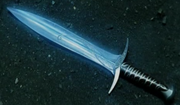No edit summary |
|||
| Line 1: | Line 1: | ||
{{Featured star}} |
{{Featured star}} |
||
| + | {{Quote|I will give you a name...and I shall call you ''Sting''.|—Bilbo Baggins}} |
||
| + | |||
[[File:Sting2.jpg|thumb]] |
[[File:Sting2.jpg|thumb]] |
||
'''Sting''' was an [[Elves|Elvish]] long knife made in [[Gondolin]] during the [[First Age]]. It is unique for being feared by the [[spiders]] of [[Mirkwood]]. |
'''Sting''' was an [[Elves|Elvish]] long knife made in [[Gondolin]] during the [[First Age]]. It is unique for being feared by the [[spiders]] of [[Mirkwood]]. |
||
Revision as of 12:09, 12 October 2013
- "I will give you a name...and I shall call you Sting."
- ——Bilbo Baggins

Sting was an Elvish long knife made in Gondolin during the First Age. It is unique for being feared by the spiders of Mirkwood.
History
Sting was an ancient blade made by Elvish weapon-smiths in Gondolin. It was lost during the Fall of Gondolin, the same battle in which Turgon fell and Glamdring was taken.
The blade was carried by Bilbo in The Hobbit after he found it in a Troll-hoard. Sting was found alongside Glamdring and Orcrist. Though just a knife by the standard of elves, it made a perfect short sword for a Hobbit, although it was still rather small, as Bilbo initially chose to wear it "inside his breeches"[1] and was still able to travel and even run without any apparent inconvenience.
Just before his nephew left on his quest to Mordor, Bilbo gave Sting to Frodo. Sam then took the weapon from his (seemingly dead) master and used it to good effect against Shelob on the borders of Mordor. After the defeat of Sauron at the end of the Third Age, Frodo entrusted Sting to Sam and it became an heirloom of the Gamgee family.
Gollum, who disliked anything made by the elves, was afraid of Sting. This fear aided Bilbo when he confronted Gollum in a cave at the base of the Misty Mountains in The Hobbit . It also helped Frodo and Sam subdue Gollum in The Lord of the Rings. Orcs also had an instinctive fear of these weapons and hated any who carried them.
As is fitting for a blade of Gondolin, Sting could easily cut through the webs of the offspring of Ungoliant, including the evil Shelob and the spiders of Mirkwood, who christened the weapon Sting after many of them had been "stung" by Bilbo with it.
Sting was like Glamdring and Orcrist in that "being the work of Elvish smiths in the Elder Days these swords shone with a cold light, if any Orcs were near at hand."[2] But only Sting was definitively described as glowing blue, or glittering with blue flame at its edges.[3]
Portrayal in adaptations

"The blade glows blue when orcs are close."
In Peter Jackson's adaptations, Sting is depicted as vaguely leaf-shaped, with gently curving edges, such as Tolkien described in his book. Engraved on the blade are Sindarin letters that read phonetically, "Maegnas aen estar nin dagnir in yngyl im". Translated they read, "Sting is my name; I am the spider's bane". According to the appendix of The Silmarillion, the element maeg in Sindarin means 'sharp' or 'piercing', and the Etymologies section in The Lost Road and Other Writings gives the meaning of the element nass as 'point', so "Maegnas" is literally translated as "sharp-point".

Bilbo holding Sting for the first time after discovering it in the troll's cave.
In the books there is no mention that Bilbo had the blade inscribed, and the inscription is not present in the The Hobbit adaptation, but after Bilbo named the blade Sting he could have had it inscribed by the elves during the story of The Hobbit or after, or the elves could have inscribed it for him after he returned to live in Rivendell. This seems likely since the engraving is in Sindarin and the elves obviously would have had the best experience in reshaping a blade such as Sting.
Despite both Glamdring and Orcrist both being elvish blades of similar make, Sting is the only blade shown to glow blue in The Hobbit and Lord of the Rings films.
Gallery
References
- ↑ The Hobbit, chapter V, "Riddles in the Dark".
- ↑ Tolkien, The Lord of the Rings, Book II, Chapter 4, "A Journey in the Dark".
- ↑ Glamdring was "bright as blue flame" in the midst of a goblin (orc) horde, but the color of its light was always described as white, and Orcrist, being the same type of blade, was probably similar in this as well.
Template:Meweapons
External links
 Sting at Tolkien Gateway
Sting at Tolkien Gateway- Sting Replica A Sting sword from BladeCenter.com




